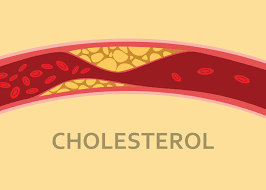By UMNA AZAM
Abstract:
According to international research studies, there is a strong link between saturated fat consumption (dairy, fats, and animal fats) and coronary heart disease (CHD).However; these research studies alone are insufficient to establish a cause-and-effect relationship between these two factors and rate of mortality. Dietary intervention trials are also required.
Cholesterol deposits make form plaque that causes the insides of the blood vessels to constrict and result in atherosclerosis. Plaque buildup in the walls of the arteries that deliver blood to the heart. Myocardial Infarction and irreversible damage to cardiac tissue are leading to death consequences of CHD. We will quickly review the risk and causes of coronary heart disease in this article.
Introduction:
Cholesterol is a type of fatty molecule found in the blood. High cholesterol levels can put you at risk for heart disease, despite the fact that your body needs cholesterol to build healthy cells.
If you have excessive cholesterol, you may develop fatty deposits in your blood vessels. These deposits gradually build up to the point that blood flow is impeded through your arteries. These deposits can rupture and create a clot, which can lead to a heart attack or stroke. Although high cholesterol can be passed down through generations, it is more often the product of bad lifestyle choices, making it both preventable and treatable. A healthy diet, regular exercise, and, in some situations, medication can help lower cholesterol levels. According to the National Heart, Lung, and Blood Institute (NHLBI), a person’s first cholesterol screening should take place between the ages of 9 and 11, and then every five years after that (NHLBI). According to the NHLBI, cholesterol screenings should be done every one to two years for men 45 to 65 and every one to two years for women 55 to 65, according to the NHLBI. Cholesterol tests should be done on anyone over the age of 65 once a year. The role of high cholesterol and oxidative stress in cardiovascular diseases has been extensively researched, as it is hypothesized that various products derived from lipid peroxidation, such as oxysterols, or altered protein expression, could cause cardiomyocyte damage, followed by pathological changes.
Cholesterol is divided into two types:
Lipoproteins are made up of a combination of proteins and cholesterol. There are several types of cholesterol, depending on what the lipoprotein transports.
Low-density lipoprotein (LDL): LDL cholesterol, also known as “bad” cholesterol, is capable of transporting cholesterol particles throughout the body. LDL cholesterol builds up in the arteries’ walls, thickening and constricting them.
High-density lipoprotein (HDL): The “good” cholesterol, HDL (high-density lipoprotein), absorbs cholesterol and transports it back to the liver. It is then evacuated from the body by the liver. High HDL cholesterol levels can help to prevent the development of disease and stroke.
Coronary artery disease (CAD) is a condition in which blood flow to the heart is obstructed. CAD, also referred to as coronary heart disease (CHD), is the most common type of heart disease, affecting 16.5 million people over the age of 20. Uncontrolled CAD can cause a heart attack.
Atherosclerosis, or vascular damage caused by cholesterol plaque formation in the arteries, is the most common cause of CAD. When one or more of these arteries become partially or totally blocked, blood flow is reduced. These arteries supply your heart with oxygen and nutrient-rich blood. Your heart is a muscular organ that is responsible for pumping blood throughout your entire body. A healthy heart pumps about 3,000 litres of blood into our body every day, according to the Cleveland Clinic. In order to function effectively, your heart, like any other organ or muscle, requires a stable supply of blood.
Symptoms of CAD can be caused by a reduction in blood flow to the heart. Other rare forms of coronary artery injury or blockage can reduce blood flow to the heart.
You may have a number of symptoms if your heart does not receive enough arterial blood. Coronary artery disease is marked by angina, which is the most common symptom (chest pain)… This soreness is described by some as follows: • chest pain; heaviness; tightness; burning; squeezing, Heartburn or indigestion can be mistaken for these symptoms. Other CAD symptoms include: arm or shoulder pain, shortness of breath, sweating, dizziness.
When your blood flow is restricted, you may feel more symptoms. If blood flow is fully or nearly completely cut off due to a blockage, your heart muscle will begin to die if it is not restored. This is the result of a heart attack. Any of these symptoms should not be ignored, especially if they are severe or remain for longer than five minutes. Medical attention is required right away. Women may have the same symptoms as men, but they’re also more likely to have
- Nausea, vomiting, back pain, jaw pain, and shortness of breath without chest discomfort.
Men are more likely than premenopausal women to get heart disease. By the age of 70, postmenopausal women are at the same risk as males. Your heart may grow weak, develop abnormal cardiac rhythms (arrhythmia), or fail to pump as much blood as your body requires as a result of decreasing blood flow. These heart problems will be observed by your doctor during the diagnostic process.
The Framingham Heart Study (FHS), published in 1957, was the first to use the terminology “risk factors” in coronary heart disease (CHD). FHS demonstrated the epidemiologic connections between cigarette smoking, blood pressure, and cholesterol levels, as well as the prevalence of coronary artery disease (CAD).The outcomes were truly revolutionary since they contributed to a shift in how medicine is performed.
High blood pressure, high cholesterol levels, and tobacco use are all risk factors.
- Fat • inactivity • insulin resistance/hyperglycemia/diabetes mellitus • a history of preeclampsia during pregnancy • poor eating habits • obstructive sleep apnea • mental stress
As people get older, their risk of coronary artery disease rises. Based only on age as a risk factor, men begin to have a higher risk of the disease at age 45, while women begin to have a higher risk at age 55. If you have a family history of coronary artery disease, your chances are even higher.
A study of your medical history, a physical examination, and other medical testing are all required to diagnose CAD. These tests include the following:
- An electrocardiogram is a test that measures the electrical signals that go through your heart. It could aid your doctor in determining if you’ve suffered a heart attack.
- This imaging test creates an image of your heart using ultrasound waves. The results of this test will disclose whether or not various components of your heart are working properly.
Stress tests, cardiac catheterization (left heart catheterization), and a heart CT scan are also included.If you’ve been diagnosed with CAD, it’s critical to minimize or control your risk factors and seek therapy to reduce your chances of having a heart attack or stroke. Treatment is also influenced by your existing health, lifestyle factors, and overall well-being. For example, if you have high cholesterol or high blood pressure, your doctor may suggest medication therapy, and if you have diabetes, you may be prescribed medicine to reduce your blood sugar. Changes in your lifestyle can also lower your risk of heart disease and stroke. Consider the following scenario:
- Stop smoking, limit or eliminate alcohol intake, exercise frequently, lower your weight to a healthy level, and consume a nutritious diet (low in saturated fat, sodium, and added sugar).
If lifestyle modifications and medicines don’t improve your condition, your doctor may advise a treatment to enhance your heart’s ability to pump. These procedures could include:
Balloon, angioplasty, coronary artery bypass graft surgery, coronary artery bypass graft surgery
Conclusion:
When you have coronary artery disease, you must be aware of your risks and take action to minimize the ones you can manage. Diet, exercise, and quitting smoking are all part of this. It’s critical to follow your doctor’s instructions for high blood pressure, high cholesterol, diabetes, and other health problems. At least one of the primary modifiable risk factors for Ischemic heart disease (IHD) is present in the majority of people with coronary artery disease. Changing these factors has the potential to lower the burden of CAD disease and cardiovascular mortality.
SUPERVISOR: DR MUHAMMAD NOMAN KHAN
Student Name: UMNA AZAM
DEPARTMENT OF PHYSIOLOGY
University of Karachi





